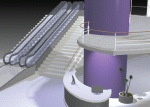
The Levytator, the world’s first escalator capable of following freeform curves, could use half of the energy of conventional designs, according to a new research paper which was presented at the UK’s Symposium on Lift and Escalator Technologies. Unlike traditional escalators, where redundant steps move underneath those in use, the Levytator utilises a continuous loop of curved modules, which can follow any path upwards, flatten and straighten out, and descend once more, all with passengers on board.
This means that a single Levytator with one power source can be used in place of two escalators with separate motors, with the weight of passengers travelling down offsetting the weight of those travelling up, hence creating substantial energy savings.
Energy reduction
The concept was developed by Jack Levy, Emeritus Professor of Mechanical Engineering at City University London, who has conducted mathematical modelling of its energy use with fellow University researcher, Elena Shcherbakova.
The resulting paper predicts that a fully-loaded Levytator (with the maximum number of passengers travelling both up and down) would use around 80% of the power of two traditional escalators making the same trips. Meanwhile, a half-loaded Levytator (with the down path full and the up path empty) would use half the energy of the two equivalent escalators.
Practical benefits
Professor Levy comments: “The Levytator was primarily developed to give architects the ability to create escalators in any shape they want, but we’ve now shown that the design could significantly cut power consumption too. As utility bills rise and more organisations strive for green accreditation for their premises, we hope the Levytator can play an important role in cutting both energy use and the associated costs.”
Aside from its aesthetic and green advantages, the Levytator also provides several practical benefits, for example maintenance is simpler, as all of the steps can be accessed from above, and no excavation is required when installing it. This means that a Levytator could be placed on top of an existing staircase, giving better access for elderly and disabled people, for example.
